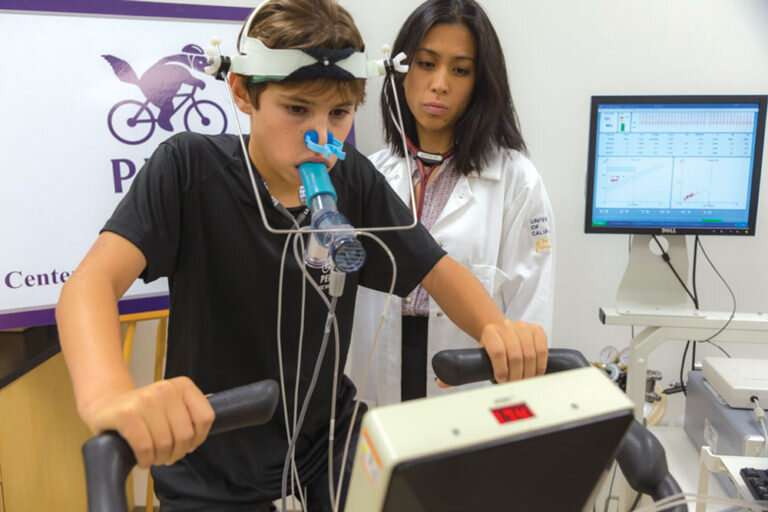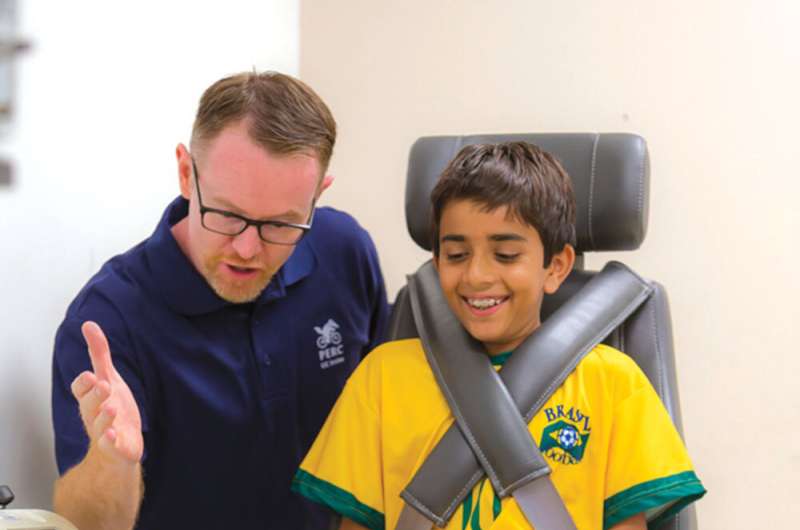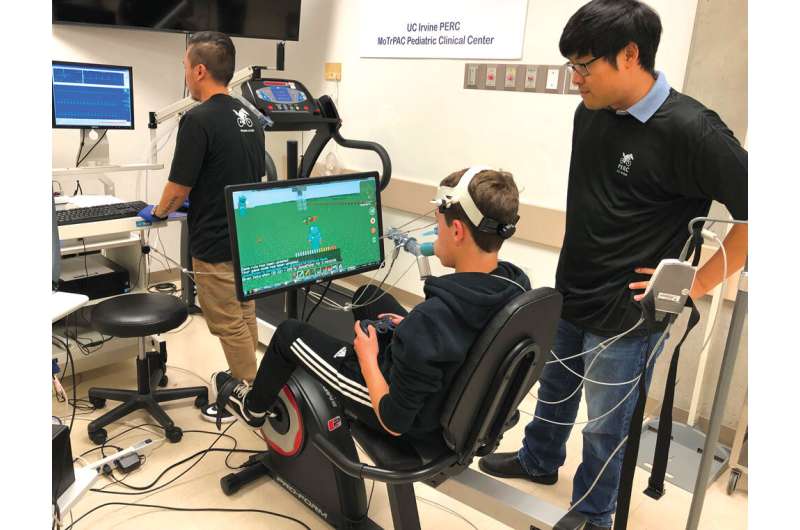A prescription for exercise

Richard Carpenter, 75, was going through the mail one day last year when he saw a postcard from UCI seeking participants for a study on whether exercise can help with age-related memory loss.
"I almost put it into the recycle pile," Carpenter says. "But I mentioned it to my wife, and she said 'Wait!' She knew I could use a program like this. For the last 20 years, I have not really been involved in exercise at all, and my memory is really bad."
Today, the retired criminal investigator for NASA works out at the Huntington Beach YMCA four times a week as part of a 15-site national study on the effects of aerobic exercise on adults with mild memory problems. The Exercise Evaluation Randomised Trial is co-led by Carl Cotman, a UCI professor of neurology and neurobiology & behavior who's a renowned expert on age-related dementia and exercise.
"What we're hoping to get with EXERT is compelling evidence that exercise can improve fitness and cognitive ability and help protect people from cognitive decline," he says. "We would like to have enough solid evidence for physicians to write prescriptions for exercise."
Across the UCI campus, researchers are exploring the impact of exercise on health from childhood until the end of life. That focus now includes a bachelor's degree in exercise science that emphasizes the health effects of physical activity. The university has a long history in exercise science, says James W. Hicks, professor of ecology & evolutionary biology and director of the campus's Center for Exercise Medicine and Sport Sciences. However, he says, the twin epidemics of obesity and diabetes have propelled research away from questions about exercise and sports performance toward the theory that "exercise is medicine."
"That concept has exploded," Hicks says. "That's where the future is: understanding how exercise alters disease trajectories and improves outcomes."
An Antidote to Aging
If anyone has been at the forefront of exercise and health, it's Cotman. More than two decades ago, his research showed that exercise increases production of a substance called brain-derived neurotrophic factor. BDNF aids in learning and memory and facilitates connections among nerve cells. It's so critical to brain function that it has been dubbed "Miracle-Gro for the brain."
"Exercise builds brain health," says Cotman, a founding director of UCI MIND, one of 30 National Institutes of Health-funded centers for aging and dementia research. "It makes you more efficient. You're thinking cleaner. It introduces a state of readiness."
The EXERT study will be a critical test of the theory that sufficient aerobic exercise can help stave off dementia. With the burgeoning number of Americans with Alzheimer's disease, its findings are highly anticipated. While Cotman has pursued his research over the past 25 years, many other dementia theories and treatments have withered away.

"Since 2002, 420 clinical trials on drugs targeted for Alzheimer's have been launched. All of them failed," Hicks notes. "No drug will change its trajectory. But physical activity might."
EXERT researchers plan to enroll 300 people, who will participate in either stretching and balance exercises or aerobic training. They'll undergo testing for cognition, brain atrophy and inflammation, as well as amyloid-tau biomarkers linked to dementia in blood and spinal fluid samples. Results could be available in about three years.
'The Best Dirty Drug Around'
Michael Yassa, UCI Chancellor's Fellow and professor of neurobiology & behavior, is known for his on-the-move meetings. Exercise is so important to health and cognition that the director of the Center for the Neurobiology of Learning & Memory and his students tackle agendas while making a loop of the campus or heading for coffee.
Yassa's translational neurobiology lab focuses on learning and memory and their role in education, technology and disease processes. He calls exercise "the best dirty drug around." In pharmaceutical science, a dirty drug is one that binds to many molecular targets in the body instead of just one. That's usually a recipe for disaster in drug development. But exercise may be the perfect dirty drug formula for overall good health and the prevention of a wide range of ailments.
"Exercise has myriad different mechanisms, and all of them are good," Yassa says. "There's something magical about it."
Physical activity is underutilized as a health prescription, he says, in part because researchers can't really explain why it works wonders for some people but not others. Nor can anyone describe the appropriate "dose" for specific conditions. That's the frontier facing 21st-century exercise scientists.
"We're entering an era in which we have to figure out how to build better exercise prescriptions," Yassa says. "We can tailor exercise interventions. It's very much consistent with the notion of precision, or personalized, medicine."
He's using highly controlled laboratory research to do that. In many of his experiments, the oxygen consumption of exercise participants is controlled, while brain function is gauged via functional MRI. In a study published last year in Proceedings of the National Academy of Sciences, Yassa and his colleagues found that memory, as measured by a test, improved in healthy young adults after just a 10-minute, light-intensity run on a treadmill. Using functional MRI, the researchers showed heightened activity in the hippocampus—the seat of memory in the brain—after the mild workout.
"People used to think, 'If I can't get out and do 30 minutes at the gym and break a sweat, it's not worth it,'" Yassa says. "But even 10 minutes of walking can give you an extra boost."
Sweat Equity

His carefully crafted PNAS study caught the attention of Dr. Francis Collins, director of the National Institutes of Health. In a blog post, Collins said the work illustrates the importance of an ongoing NIH-funded project exploring the molecular, or cellular, changes that arise with physical activity. The project is called the Molecular Transducers of Physical Activity Consortium, and UCI is involved in that project too.
The UCI Health Pediatric Exercise and Genomics Research Center is one of just 11 sites participating in MoTrPAC—and the only one focusing on children. There, you'll find youngsters on treadmills or engaged in resistance training. It's among the very few research facilities in the country with state-of-the-art pediatric performance labs in which to conduct exercise tests and evaluate the effects at the molecular level.
By examining children before and after exercise—for example, by looking at blood samples to analyze genetic and molecular affects—MoTrPAC will develop a database on how a child's cells respond to exercise, a database that can be accessed by scientists around the world, according to Shlomit Radom-Aizik, PERC's founder and executive director.
"This will bring exercise science to a completely different level," she says. "Understanding the mechanisms is where we'll have an opportunity to make a huge leap and be able to use exercise as medicine."
The study, which is being undertaken in collaboration with the UCI Institute for Clinical and Translational Science, includes children between the ages of 10 and 17 from local schools. Nationwide, MoTrPAC will collect data from a diverse group of 2,700 people up to age 75.
Center experts also conduct other research, such as looking at the impact of exercise on youngsters with chronic conditions like asthma, autism and cystic fibrosis, as well as children who have survived cancer. Unlike adults, who may have to drag themselves to the gym, pediatric subjects embrace moving, Radom-Aizik notes.
"In our studies," she says, "we make it clear to the children that they're part of something that's going to benefit them and help us develop and implement exercise programs for other children with different clinical conditions. They love that."
Similarly, retiree Carpenter enjoys participating in the EXERT project. "You huff and puff," he says. "It's not only good for me, but what I'm doing will be analyzed at a future time and maybe add a little bit of information to the big picture."
All of the EXERT sites are affiliated with local YMCAs. This was done for a reason, Cotman says: so the study's results won't be confined to the pages of a science journal.
"It gives us a community-based organization that knows how to do this once the trial is done," he says. "There will be a place where people can continue to practice the exercises and bring new people in. Translation to the public is essential."




















